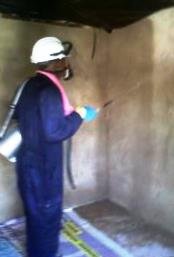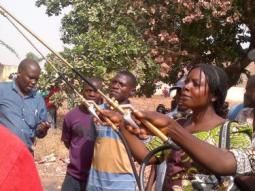 Inyama, P.U., Samdi, L., Nsa, H., Iwuchukwu, N. Suleiman, H., Kolyada, L., Dengela, D., Lucas, B., Seyoum, A. and Fornadel, C. Are associated with the PMI/AIRS Project in Nigeria. They presented their experiences with IRS at the recently concluded Multilateral Initiative for Malaria 6th Pan African Malaria Conference in Durban South Africa. They have shared their presentation here.
Inyama, P.U., Samdi, L., Nsa, H., Iwuchukwu, N. Suleiman, H., Kolyada, L., Dengela, D., Lucas, B., Seyoum, A. and Fornadel, C. Are associated with the PMI/AIRS Project in Nigeria. They presented their experiences with IRS at the recently concluded Multilateral Initiative for Malaria 6th Pan African Malaria Conference in Durban South Africa. They have shared their presentation here.
The President’s Malaria Initiative’s Africa Indoor Residual project (PMI/AIRS), IRS 2 Task Order 4, executed the year 2 spray operation in Nasarawa Eggon and Doma Local Government Areas (LGA) of Nasarawa State, Nigeria. The objectives of the program being the reduction of malaria – associated morbidity and mortality, a total of 62,592 structures were sprayed. To measure the impact of the IRS program on the malaria vectors the proportion of parous mosquitoes in the vector population was determined before and after Indoor Residual Spraying.
 One thousand, six hundred and twenty one (1,621) female Anopheles gambiae s.l. specimens drawn from a pool of 3,356 Female Anopheline mosquitoes captured by Human Landing Catches from three LGAs of Nassarawa Eggon and Doma (intervention areas) and Lafia (Control) of Nasarawa State Nigeria were dissected using WHO-recommended techniques for parity. The degree of coiling of ovarian tracheoles was observed pre-IRS intervention in March 2013 and monthly post IRS intervention up to September 2013. Proportion of parous females was compared pre-and between intervention and control villages. Similarly, pre-and post-spray proportion of parous comparison was made within both intervention and control villages.
One thousand, six hundred and twenty one (1,621) female Anopheles gambiae s.l. specimens drawn from a pool of 3,356 Female Anopheline mosquitoes captured by Human Landing Catches from three LGAs of Nassarawa Eggon and Doma (intervention areas) and Lafia (Control) of Nasarawa State Nigeria were dissected using WHO-recommended techniques for parity. The degree of coiling of ovarian tracheoles was observed pre-IRS intervention in March 2013 and monthly post IRS intervention up to September 2013. Proportion of parous females was compared pre-and between intervention and control villages. Similarly, pre-and post-spray proportion of parous comparison was made within both intervention and control villages. Overall, a total of 1,621 ovaries of An. gambiae s.l. were dissected before and after IRS intervention. Of the ovaries dissected at baseline, 71.43% were parous in Nassarawa Eggon, 76.70% in Doma and 77% in the control area. After IRS in May 2013, it was found that the parity had declined dramatically to 17.69% in Nassarawa Eggon, 27.98% in Doma (p <0 .05="" 31="" 68="" afia="" and="" area="" areas="" as="" continued="" control="" decline="" doma="" efficacy="" for="" ggon="" high="" in="" increase="" insecticide="" intervention="" it="" month.="" n="" observed="" p="" parity="" rate="" remained="" residual="" respectively="" same="" september="" slight="" the="" to="" was="" while="">
Overall, a total of 1,621 ovaries of An. gambiae s.l. were dissected before and after IRS intervention. Of the ovaries dissected at baseline, 71.43% were parous in Nassarawa Eggon, 76.70% in Doma and 77% in the control area. After IRS in May 2013, it was found that the parity had declined dramatically to 17.69% in Nassarawa Eggon, 27.98% in Doma (p <0 .05="" 31="" 68="" afia="" and="" area="" areas="" as="" continued="" control="" decline="" doma="" efficacy="" for="" ggon="" high="" in="" increase="" insecticide="" intervention="" it="" month.="" n="" observed="" p="" parity="" rate="" remained="" residual="" respectively="" same="" september="" slight="" the="" to="" was="" while=""> This study has shown a reduction in the longevity of Anopheles mosquitoes post spraying as compared to pre-spraying in the intervention villages. The longevity of the vector was also significantly declined post spraying in the intervention villages as compared to unsprayed villages. The observed reduction of the expectation of life of the vector associated with IRS is promising. But further study is needed to fully understand how this will be translated to reduction of malaria transmission in the area.
This study has shown a reduction in the longevity of Anopheles mosquitoes post spraying as compared to pre-spraying in the intervention villages. The longevity of the vector was also significantly declined post spraying in the intervention villages as compared to unsprayed villages. The observed reduction of the expectation of life of the vector associated with IRS is promising. But further study is needed to fully understand how this will be translated to reduction of malaria transmission in the area. We wish to thank all technicians who participated in the entomological surveillance activities and dissection of mosquitoes. This work was funded by the President’s Malaria Initiative.www.africairs.net and info@africairs.net
We wish to thank all technicians who participated in the entomological surveillance activities and dissection of mosquitoes. This work was funded by the President’s Malaria Initiative.www.africairs.net and info@africairs.net










No comments:
Post a Comment